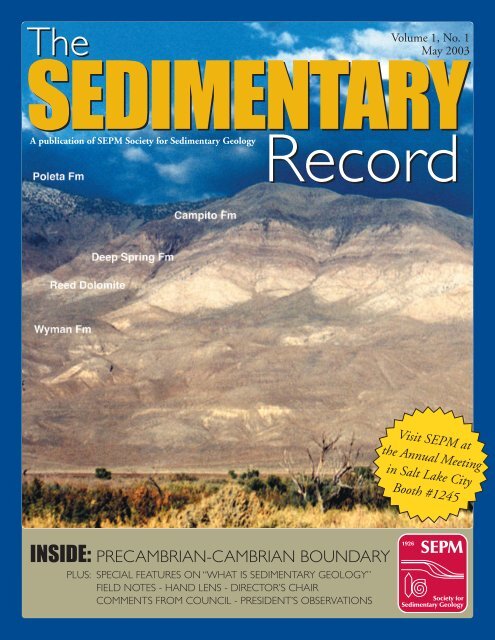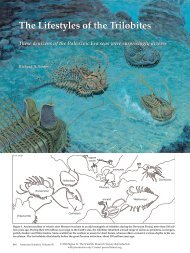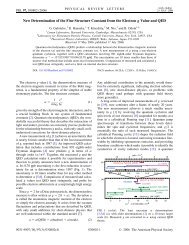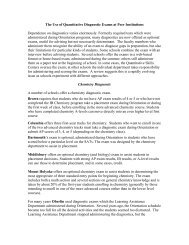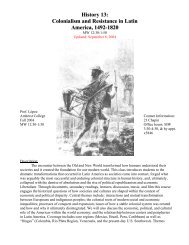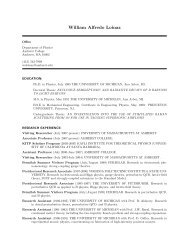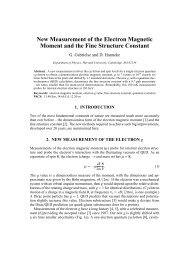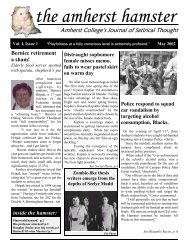sedimentary sedimentary - SEPM
sedimentary sedimentary - SEPM
sedimentary sedimentary - SEPM
You also want an ePaper? Increase the reach of your titles
YUMPU automatically turns print PDFs into web optimized ePapers that Google loves.
The<br />
SEDIMENTARY<br />
A publication of <strong>SEPM</strong> Society for Sedimentary Geology<br />
Volume 1, No. 1<br />
May 2003<br />
Record<br />
Visit <strong>SEPM</strong> at<br />
the Annual Meeting<br />
in Salt Lake City<br />
Booth #1245<br />
INSIDE: PRECAMBRIAN-CAMBRIAN BOUNDARY<br />
PLUS: SPECIAL FEATURES ON “WHAT IS SEDIMENTARY GEOLOGY”<br />
FIELD NOTES - HAND LENS - DIRECTOR’S CHAIR<br />
COMMENTS FROM COUNCIL - PRESIDENT’S OBSERVATIONS
AAPG/<strong>SEPM</strong><br />
Annual Meeting<br />
May 11-14, 2003<br />
Salt Lake City, UT<br />
Salt Palace Convention Center<br />
<strong>SEPM</strong> Business Meeting<br />
and Luncheon<br />
Date: Tuesday, May 13 h<br />
Time: 11:30 a.m.-1:30 p.m.<br />
Location: The Salt Lake City Marriott<br />
Hotel Downtown<br />
Fee: $30<br />
This year <strong>SEPM</strong>’s distinguished<br />
speaker is Henry W. Posamentier, General<br />
Manager of Geoscience and Technology<br />
at Anadarko Canada, Inc. Dr.<br />
Posamentier specializes in sequence<br />
stratigraphy and facies analysis of<br />
depositional systems.<br />
The title of Posamentier’s presentation<br />
is “Bringing Stratigraphy into the 21 st<br />
century–Extraction of Stratigraphic and<br />
Geologic Facies Information from 3D Seismic<br />
Data Sets.”<br />
The <strong>SEPM</strong> Luncheon will begin<br />
with a cash bar reception at 11:30 a.m.,<br />
followed by lunch shortly after. The<br />
Business Meeting will start once lunch<br />
has been served with the speaker’s<br />
presentation to begin after lunch.<br />
Luncheon tickets are $30 per person and<br />
may be purchased on-site at the AAPG<br />
Registration Desk.<br />
<strong>SEPM</strong> President<br />
esident’s s Reception<br />
and Awar<br />
wards Ceremony<br />
emony<br />
Date: Tuesday, May 13<br />
Time: 7:00-8:30 p.m.<br />
Location: The Salt Lake City Marriott<br />
Hotel Downtown<br />
<strong>SEPM</strong> President Peter McCabe and<br />
the Council of the Society invite you to an<br />
evening of celebration to honor the 2003<br />
awardees of the Society for Sedimentary<br />
Geology (<strong>SEPM</strong>):<br />
Twenhofel Medal<br />
Gerard Middleton<br />
Raymond C. Moore Medal<br />
George Pemberton<br />
Pettijohn Medal<br />
Lawrence Hardie<br />
Francis P. . Shepar<br />
hepard d Medal<br />
Harry Roberts<br />
Wilson Awar<br />
ward<br />
Samuel Bentley<br />
Honorary Membership<br />
Edward B. Picou, Jr.<br />
Outstanding Paper in JSR, 2001:<br />
Stephen Meyers, Bradley Sageman<br />
and Linda Hinnov<br />
Outstanding Paper in PAL<br />
ALAIOS, AIOS, 2001:<br />
T.D. Olszewski,<br />
and M.E. Patzkowsky<br />
Excellence of Oral Presentation, 2002:<br />
A.R. Sprague, P.E. Patterson,<br />
R.E. Hill, C.R. Jones,<br />
K.M. Campion, J.C. Van Wagoner,<br />
M.D. Sullivan, D.K. Larue,<br />
H.R. Feldman, T.M. Demko,<br />
R. W. Wellner, and J.K. Geslin<br />
Excellence of Poster Presentation, 2002:<br />
D.C. Twitchell, V.A. Cross,<br />
and M. Rudin<br />
<strong>SEPM</strong> will also be recognizing the<br />
members of the 2003 Local Organizing<br />
Committee and student winners.<br />
The reception will begin at 7:00 p.m.,<br />
with cash bars and hors d’oeuvres. The<br />
ceremony will start at 7:30 p.m.<br />
Research Groups<br />
2pm-5pm, Sun. May 11:<br />
• Clastic Diagenesis<br />
7:00-10pm, Mon. May 12:<br />
• Carbonates<br />
• Marine Micropaleontology<br />
• Quantitative Stratrigraphy<br />
• Sequence Stratrigraphy<br />
6-7pm, Tues. May 13:<br />
• CRER-Working Group IV<br />
7:30-9:30pm, Tues. May 13:<br />
• Deep Water<br />
<strong>SEPM</strong> Foundation Activities<br />
9-10am, Mon. May 12<br />
Foundation Board Meeting<br />
10-11am, Mon. May 12<br />
Foundation Members Meeting<br />
6-7pm, Tues. May 13<br />
Foundation Donors Reception<br />
The <strong>SEPM</strong> Council<br />
2002 - May 2003:<br />
President:<br />
Peter McCabe<br />
President-Elect:<br />
John B. Anderson<br />
Secr<br />
ecretar<br />
etary-T<br />
y-Treasur<br />
easurer:<br />
er:<br />
William A. Morgan<br />
Councilor for Paleontology:<br />
Thomas W. Dignes<br />
Councilor for Sedimentology:<br />
Cathy J. Busby<br />
International Councilor:<br />
Ole Martinsen<br />
Councilor for Research Activities:<br />
John R. Suter<br />
Co-Editors, JSR:<br />
David A. Budd, Mary J. Kraus<br />
Editor<br />
ditor, , PAL<br />
ALAIOS:<br />
AIOS:<br />
Chris Maples<br />
Editor<br />
ditor, , Special Publications:<br />
Laura J. Crossey<br />
President, <strong>SEPM</strong> Foundation, Inc.:<br />
Tim Carr<br />
New officers for 2003 - 2004:<br />
President:<br />
John B. Anderson<br />
President-Elect:<br />
Rick Sarg<br />
Councilor for Sedimentology:<br />
Maria Mutti<br />
Councilor for Paleontology:<br />
Dawn Sumner<br />
We look forward to seeing you in Salt Lake City!
The Sedimentary Record<br />
Cover photo: Precambrian-Cambrian boundary interval in the<br />
White-Inyo succession, White Mountains, view to the east from<br />
Highway 395 between Bishop and Big Pine, California<br />
(see Corsetti and Hagadorn, this issue). Photo by F.A. Corsetti.<br />
Editors<br />
Loren E. Babcock, Department of Geological Sciences, The<br />
Ohio State University, Columbus, Ohio 43210<br />
<br />
Stephen A. Leslie, Department of Earth Science, University of<br />
Arkansas at Little Rock, Little Rock, Arkansas 72204<br />
<br />
Marilyn D. Wegweiser, Department of Biological and<br />
Environmental Sciences, Georgia College and State University,<br />
Milledgeville, Georgia 31061 <br />
<strong>SEPM</strong> Staff<br />
6128 East 38th Street, Suite #308,Tulsa, OK 74135-5814<br />
Phone (North America): 800-865-9765<br />
Phone (International): 918-610-3361<br />
Dr. Howard Harper, Executive Director<br />
<br />
Theresa Scott, Business Manager<br />
<br />
Kris A. Farnsworth, Publications Coordinator<br />
<br />
Judy Tarpley, Event and Conference Manager<br />
<br />
Michele Woods, Membership Services Associate<br />
<br />
Welcome to<br />
The Sedimentary Record<br />
This is the inaugural issue of The Sedimentary Record, a new<br />
series published quarterly in both online and paper format by<br />
<strong>SEPM</strong> (Society for Sedimentary Geology). The Sedimentary<br />
Record contains peer-reviewed science articles on topics of broad<br />
and current interest to the membership of <strong>SEPM</strong>, as well as<br />
shorter, editor-reviewed articles addressing a variety of topics,<br />
including society business and media reviews. We welcome written<br />
contributions from members of the Society for inclusion in<br />
the journal. We also look forward to receiving suggestions concerning<br />
how The Sedimentary Record should evolve in order to<br />
meet its dual goals of serving 1) as an outlet for communicating<br />
information important to the Society; and 2) as a focal point for<br />
discussion of current topics, and topics pertinent to the future of<br />
<strong>sedimentary</strong> geology.<br />
Manuscripts to be considered for publication should be submitted<br />
to the editors in electronic format, and preferably by e-<br />
mail. Upon acceptance, it is anticipated that papers will be published<br />
quickly. Publication will include online availability<br />
through the <strong>SEPM</strong> website.<br />
We are proud to be associated with this new publication venue<br />
of <strong>SEPM</strong>, and look forward to working with many of you in the<br />
membership of the Society to bring important, current topics to<br />
publication in a rapid manner.<br />
— The Editors<br />
CONTENTS<br />
4 The Precambrian-Cambrian Transition<br />
in the Southern Great Basin, USA<br />
9 President’s Observations:<br />
A Global Earth<br />
9 Comments from the council:<br />
The <strong>SEPM</strong> Foundation<br />
10 The Hand Lens—a student forum<br />
The evolution of the multi-hat head<br />
11 Field notes:<br />
Industry Viewpoints<br />
12 From the Director’s Chair:<br />
Future of Sedimentary Geology<br />
The Sedimentary Record is published quarterly by the Society for<br />
Sedimentary Geology with offices at 6128 East 38th Street, Suite 308,<br />
Tulsa, OK 74135-5814, USA.<br />
Copyright 2003, Society for Sedimentary Geology. all rights reserved. Opinions<br />
presented in this publication do not reflect official positions of the Society.<br />
The Sedimentary Record is provided as part of membership dues to the<br />
Society for Sedimentary Geology.<br />
May 2003 | 3
The Sedimentary Record<br />
The Precambrian-<br />
Cambrian Transition in the<br />
Southern Great Basin, USA<br />
Frank A. Corsetti<br />
Department of Earth Science<br />
University of Southern California<br />
Los Angeles, CA 90089-0740<br />
fcorsett@usc.edu<br />
ABSTRACT:The Precambrian-Cambrian boundary presents an interesting<br />
stratigraphic conundrum: the trace fossil used to mark and correlate the base of the<br />
Cambrian, Treptichnus pedum, is restricted to siliciclastic facies, whereas<br />
biomineralized fossils and chemostratigraphic signals are most commonly obtained<br />
from carbonate-dominated sections.Thus, it is difficult to correlate directly between<br />
many of the Precambrian-Cambrian boundary sections, and to assess details of the<br />
timing of evolutionary events that transpired during this interval of time.Thick<br />
sections in the White-Inyo region of eastern California and western Nevada, USA,<br />
contain mixed siliciclastic-carbonate lithofacies, and therefore promote correlation<br />
between these classic, well-studied lithologic end-members.An integrated<br />
stratigraphic approach was applied to the White-Inyo succession, combining<br />
lithologic, paleontologic, and chemostratigraphic data, in order to address the<br />
temporal framework within the basin, and to facilitate worldwide correlation of the<br />
boundary. Results from the southern Great Basin demonstrate that the negative<br />
δ 13 C excursion that is ubiquitous in carbonate-dominated successions containing<br />
small shelly fossils occurs within stratigraphic uncertainty of the first occurrence of<br />
T. pedum.This global geochemical marker thus provides a link with the primary<br />
biostratigraphic indicator for the Precambrian-Cambrian boundary.<br />
INTRODUCTION<br />
The Precambrian-Cambrian (PC-C) transition<br />
records one of the most important<br />
intervals in the history of life, because it<br />
encompasses the appearance and diversification<br />
of metazoans, the invasion of the infaunal<br />
realm, the advent of biomineralization<br />
and predation, as well as dramatic isotopic<br />
and atmospheric changes (Lipps and Signor,<br />
1992; Bengtson, 1994; Knoll and Carroll,<br />
1999; Bottjer et al., 2000; Knoll, 2000;<br />
Babcock et al., 2001; Fig. 1). Here we draw<br />
a distinction between the PC-C transition,<br />
represented by the post-glacial terminal<br />
Proterozoic through the early Cambrian (ca.<br />
600-520 Ma), and the PC-C boundary, a<br />
chronostratigraphic boundary represented<br />
by a point in rock (Global Standard-stratotype<br />
Section and Point, or GSSP) in the<br />
Fortune Head, Newfoundland, section<br />
(Landing, 1994). The GSSP section is composed<br />
predominantly of siliciclastics<br />
(Narbonne et al., 1987), and the fossil chosen<br />
to coincide with the boundary,<br />
Treptichnus (or Phycodes) pedum, is restricted<br />
to siliciclastic facies. T. pedum recently has<br />
been demonstrated to occur ~ 4 m below<br />
4 | May 2003<br />
James W. Hagadorn<br />
Department of Geology<br />
Amherst College<br />
Amherst, MA 01002<br />
jwhagadorn@amherst.edu<br />
the GSSP (Gehling et al., 2001).<br />
Approximately 70% of all PC-C boundary<br />
successions are siliciclastic (Landing, 1994).<br />
However, many carbonate successions<br />
around the world have been more intensely<br />
studied because they record the advent of<br />
widespread biomineralization and easily<br />
obtainable δ 13 C chemostratigraphic records<br />
(summarized in Kaufman et al., 1997;<br />
Shields et al., 1997; Bartley et al., 1998;<br />
Shields, 1999; Corsetti and Hagadorn,<br />
2000; Shen and Schidlowski, 2000). Due to<br />
endemic biotas and facies control, it is difficult<br />
to correlate directly between siliciclastic-<br />
and carbonate-dominated successions.<br />
This is particularly true for the PC-C<br />
boundary interval because lowermost<br />
Cambrian biotas are highly endemic and<br />
individual, globally distributed guide fossils<br />
are lacking (Landing, 1988; Geyer and<br />
Shergold, 2000).<br />
Determination of a stratigraphic boundary<br />
generates a large amount of interest<br />
because it provides scientists with an opportunity<br />
to address a variety of related issues,<br />
including whether the proposed boundary<br />
position marks a major event in Earth history.<br />
Sometimes the larger-scale meaning of<br />
the particular boundary can be lost during<br />
the process of characterization. This is<br />
demonstrated in a plot of PC-C boundary<br />
papers through time (Fig. 2): an initial<br />
“gold rush” to publish on the boundary<br />
occurred after the formation of the working<br />
group on the PC-C boundary in the early<br />
1970s; papers trailed off though the 1980s,<br />
and plummeted after the GSSP was ratified<br />
by the International Union of Geological<br />
Sciences (IUGS) in 1992 (Rowland and<br />
Corsetti, 2002). As our understanding of<br />
this interval of Earth history grows, we<br />
focus more on the “bigger picture” issues<br />
(e.g., evolution and diversification of the<br />
Metazoa), and focus less on the “boundary<br />
issues.” However, we will inevitably seek tie<br />
points with which to link fossils from siliciclastic<br />
sections to the geochemical and climate-change<br />
data from carbonate-dominated<br />
sections so that we can improve our<br />
understanding of this critical interval.<br />
Mixed siliciclastic-carbonate successions<br />
become crucial in the search for stratigraphic<br />
tie points. Although a number of important<br />
lower Cambrian sections containing<br />
mixed siliciclastic-carbonate successions are<br />
Figure 1. Summary of pertinent features associated with the PC-C transition (data compiled principally<br />
from Droser and Bottjer, 1988; Crimes, 1992; Droser et al., 1999, 2002; Knoll and Carroll, 1999;<br />
McIlroy and Logan, 1999), demonstrating the biospheric changes represented in this interval. SSFs:<br />
small shelly fossils. Arrow denotes the first appearance of vertically-oriented bioturbation.
Figure 2. PC-C boundary publications through<br />
time (constructed by searching GEOREF for<br />
‘Precambrian-Cambrian,’ ‘Proterozoic-<br />
Cambrian,’ and ‘Neoproterozoic-Cambrian’ in<br />
the title).<br />
known (e.g., Mongolia, Brasier et al., 1996;<br />
Olenik uplift, Siberia, Knoll et al., 1995;<br />
Mackenzie Mountains, northwestern<br />
Canada, Narbonne and Aitken, 1995;<br />
southern Great Basin, Corsetti and<br />
Hagadorn, 2000), not all of these contain<br />
the PC-C boundary. Also, not all the sections<br />
contain an appropriate juxtaposition<br />
of carbonate- and trace-fossil-rich siliciclastic<br />
strata. Thick, relatively complete, wellexposed,<br />
and easily accessible successions in<br />
the southern Great Basin contain siliciclastic<br />
units and the boundary-marking fossil, T.<br />
pedum, in association with carbonate units<br />
recording a complete δ 13 C chemostratigraphic<br />
profile (Corsetti and Kaufman,<br />
1994; Corsetti et al., 2000; Corsetti and<br />
Hagadorn, 2000; Hagadorn and Waggoner,<br />
2000). The southern Great Basin sections<br />
provide an excellent opportunity to compare<br />
results from a variety of stratigraphic<br />
approaches that have emerged as useful for<br />
correlating potential stage and series boundaries<br />
within the Cambrian (e.g., Geyer and<br />
Shergold, 2000).<br />
The Sedimentary Record<br />
Figure 3. A. Map showing distribution of four<br />
interfingering facies successions that span the<br />
PC-C interval in the southern Great Basin; successions<br />
become progressively thicker to the<br />
northwest, the offshore direction (after Nelson,<br />
1978; Corsetti et al., 2000; Fedo and Cooper,<br />
2001). B. Shaded area represents the approximate<br />
PC-C outcrop belt in the southern Great<br />
Basin (after Stewart, 1970); the Mt. Dunfee<br />
section was offset to its present position by post-<br />
Cambrian transtensional faulting.<br />
GEOLOGIC BACKGROUND<br />
From the time of Walcott (1908), the thick,<br />
superbly exposed, and highly fossiliferous<br />
Lower Cambrian strata from the southwestern<br />
United States (Figs. 3, 4, cover photo)<br />
have proved instrumental for understanding<br />
the Cambrian biotic explosion, and have<br />
even been suggested for a potential basal<br />
Cambrian stratotype (Cloud, 1973).<br />
Proterozoic—lower Paleozoic strata in the<br />
southern Great Basin were deposited on a<br />
thermally subsiding trailing margin created<br />
through rifting of the Laurentian craton in<br />
the Neoproterozoic (e.g., Stewart, 1966,<br />
1970; Stewart and Suczek, 1977; Armin<br />
and Mayer, 1983; Bond et al., 1985).<br />
Neoproterozoic-Cambrian strata in the<br />
southwestern United States thicken from<br />
southeast to northwest, and can be grouped<br />
into four distinct but interfingering successions:<br />
Craton, Craton Margin, Death Valley<br />
(proximal-shelf), and White-Inyo (proximal-<br />
to mid-shelf) successions (Stewart,<br />
1970; Nelson, 1976, 1978; Mount et al.,<br />
1991; Corsetti and Hagadorn, 2000; Fedo<br />
and Cooper, 2001; Fig. 3). An erosional disconformity<br />
removed the PC-C boundary<br />
interval in the Craton and Craton Margin<br />
successions (Fedo and Cooper, 1990, 2001).<br />
This sequence boundary is traceable from<br />
the Craton Margin through the Death<br />
Valley succession to the White Inyo succession,<br />
and probably represents the “Sauk I”<br />
disconformity (Palmer, 1981). The boundary<br />
interval resides below this unconformity<br />
where incision was limited. The Death<br />
Valley succession records both appropriate<br />
trace fossil biostratigraphy and carbon isotope<br />
data (Corsetti and Hagadorn, 2000).<br />
However, the sections are relatively thin and<br />
the carbonates from which the δ 13 C record<br />
was recovered are particularly thin. The<br />
White-Inyo succession is thickest, but, until<br />
now, has been considered poorly fossiliferous<br />
with respect to earliest Cambrian guide<br />
fossils (e.g., Signor and Mount, 1986).<br />
Trilobites, which are important guide fossils<br />
in Lower Cambrian sections in the Great<br />
Basin (e.g., Nelson, 1976; Palmer, 1981,<br />
1998; Hollingsworth, 1999), make their<br />
first appearance well above this interval<br />
(Hollingsworth, 1999).<br />
White-Inyo Succession<br />
In ascending order, the White-Inyo<br />
Succession consists of the Wyman<br />
Formation, Reed Dolomite, Deep Spring<br />
Formation, Campito Formation, Poleta<br />
Formation, Harkless Formation, and the<br />
Mule Spring Limestone (Nelson, 1962; Fig.<br />
4). The White-Inyo Mountains have been<br />
the focus of intense PC-C boundary study,<br />
but the paucity of earliest Cambrian fossils<br />
has been problematic (e.g., Cloud and<br />
Nelson, 1966; Taylor, 1966; Alpert, 1977;<br />
Figure 4. Generalized lithostratigraphic columns<br />
for the PC-C transition interval in the southern<br />
Great Basin (after Nelson, 1962, 1976; Stewart,<br />
1970; Fedo and Cooper, 2001). Whereas the<br />
Lower Cambrian portion is well constrained and<br />
correlated between the intervals, correlations<br />
between Neoproterozoic strata are less well constrained.<br />
Base of the Sauk I Sequence removes some<br />
of the Neoproterozoic-Lower Cambrian interval in<br />
more proximal (Craton Margin) settings. The<br />
Death Valley succession contains a Neoproterozoic<br />
glacial-cap-carbonate succession, but no known<br />
correlatives exist in the White-Inyo succession.<br />
Fossil symbols represent first occurrences of key taxa.<br />
May 2003 | 5
The Sedimentary Record<br />
Figure 5: A.<br />
Helminthoidichnites<br />
on bed sole, Wyman<br />
Formation, south of<br />
Hines Ridge,<br />
Andrews Mountain,<br />
California (scale<br />
bar=1 cm increments).<br />
B. Domal<br />
stromatolites,<br />
Middle Deep Spring<br />
Formation, Mt.<br />
Dunfee, Nevada<br />
(knife ~8 cm long).<br />
C. Packstone lag bed<br />
composed mostly of<br />
Cloudina riemkeae<br />
(across middle of<br />
photo), Lower Deep<br />
Spring Formation,<br />
Mt. Dunfee,<br />
Nevada (field of<br />
view ~32 cm wide).<br />
D. Close-up of area<br />
shown in Fig. 5C<br />
showing C. riemkeae<br />
debris (field of view<br />
~5 cm wide). E.<br />
Treptichnus pedum,<br />
Upper Deep Spring<br />
Formation, Andrews<br />
Mountain,<br />
California (field of<br />
view ~9 cm wide).<br />
F. Cruziana and<br />
Diplichnites, Upper<br />
Deep Spring<br />
Formation, Hines<br />
Ridge, California<br />
(field of view ~9 cm<br />
wide).<br />
Nelson, 1976, 1978; Mount et al., 1983;<br />
Signor et al., 1983; Gevirtzman and Mount,<br />
1986; Signor and Mount, 1986; Droser and<br />
Bottjer, 1988; Corsetti and Kaufman, 1994;<br />
Fritz, 1995; Hagadorn and Bottjer, 1999;<br />
Hagadorn et al., 2000). Because the PC-C<br />
boundary paradigm has changed over the<br />
last three decades, the inferred position of<br />
the boundary in the succession has changed<br />
as well. New fossil evidence (Fig. 5) is consistent<br />
with the position of the boundary.<br />
More comprehensive biostratigraphic information<br />
is contained in the cited references.<br />
The Wyman Formation consists of<br />
interbedded mudrock, siltstone, and<br />
quartzite, with lensoidal oolitic, pisolitic,<br />
and oncolitic carbonate layers that increase<br />
in number upsection. Near Andrews<br />
Mountain in the Inyo Range, the<br />
formation exceeds 3000 meters in<br />
thickness (Nelson, 1962). The<br />
section primarily represents shallow<br />
marine deposition. The base<br />
of the formation is not exposed,<br />
so the nature of any underlying<br />
contact in not known (Nelson,<br />
1962). The Reed Dolomite rests<br />
unconformably on the Wyman at<br />
most localities and is divided into<br />
three members: the Lower<br />
Member, Hines Tongue, and the<br />
Upper Member. The Lower<br />
Member is characterized by<br />
coarsely-crystalline pink dolostone<br />
with cross-bedded oolitic<br />
horizons, and minor domal stromatolite<br />
horizons. This suggests<br />
subtidal to intertidal marine deposition.<br />
The Hines Tongue is a<br />
southward-thickening siliciclastic<br />
unit consisting of hummockycrossbedded<br />
sandstone and minor<br />
siltstone with minor carbonate<br />
interbeds. Thus suggests deposition<br />
below normal wave base but<br />
above storm wave base. The<br />
Hines Tongue is thickest in the<br />
Hines Ridge area of the Inyo<br />
Range, and thins dramatically to<br />
the north in the White<br />
Mountains and Esmeralda<br />
County, Nevada. The Upper<br />
Member is characterized by massive<br />
dolostones. Minor karstification<br />
is present at the contact with<br />
the overlying Deep Spring<br />
Formation at some localities.<br />
The Deep Spring Formation is<br />
formally divided into the Lower,<br />
Middle, and Upper Members,<br />
each consisting of a siliciclastic-carbonate<br />
couplet (Gevirtzman and Mount, 1986;<br />
Mount et al., 1991). The siliciclastic halfcycle<br />
of each member contains green, ripple<br />
cross-laminated siltstones, and quartzites<br />
with hummocky cross-stratification, indicating<br />
deposition in relatively shallow water<br />
above storm wave base. The boundary<br />
between the siliciclastic and carbonate halfcycle<br />
is transitional at most localities. The<br />
carbonate half-cycle is commonly characterized<br />
by rhythmically interbedded carbonate<br />
wackestone and siliciclastic-rich siltstone,<br />
crossbedded oolite, and intraclastic grainstone;<br />
a high-energy, shallow-water depositional<br />
environment is indicated. The top of<br />
each carbonate half-cycle is commonly<br />
dolomitized, and often shows minor karstification;<br />
periodic emergence is indicated.<br />
Overall, <strong>sedimentary</strong> stacking patterns, <strong>sedimentary</strong><br />
structures, and facies associations<br />
suggest that each member represents a shallowing-upward<br />
parasequence. Sharp disconformities<br />
divide the members (but see<br />
Mount et al., 1991). The Campito, Poleta,<br />
Harkless (and Saline Valley), and Mule<br />
Spring formations record similar shallow<br />
marine, mixed-siliciclastic carbonate strata<br />
(e.g., Moore, 1976; Mount and Bergk,<br />
1998), and have similar <strong>sedimentary</strong> origins.<br />
The White-Inyo succession contains a<br />
number of body and trace fossils. We have<br />
identified bed-parallel tubular trace fossils,<br />
including Helminthoidichnites and Planolites<br />
(Fig. 5A), in the Wyman Formation; we<br />
cannot falsify the hypothesis that some of<br />
these are body fossils. The Hines Tongue of<br />
the Reed Dolomite contains a depauperate<br />
suite of bed-parallel trace fossils, such as<br />
Helminthoidichnites, Planolites, and<br />
Torrowangea, and the Upper Member contains<br />
packstones of the body fossil Cloudina.<br />
Carbonates of the Lower and Middle<br />
Members of the Deep Spring Formation<br />
contain Cloudina (in skeletal lags and isolated<br />
occurrences; Figs. 5C, D). These fossils<br />
were initially identified as Cambrian small<br />
shelly fossils (Signor et al., 1983) but were<br />
subsequently reinterpreted as the<br />
Neoproterozoic Cloudina (Grant, 1990). It<br />
remains unclear whether all of the forms<br />
reinterpreted as Cloudina are, in fact,<br />
Cloudina or whether some are small shelly<br />
fossils. Siliciclastics of the Middle Member<br />
also contain rare examples of Cloudina and<br />
bed-parallel trace fossils, including Planolites<br />
and Plagiogmus. Treptichnus pedum (Fig.<br />
5E), which delineates the PC-C boundary,<br />
occurs near the top of the Middle Member<br />
in the Mt. Dunfee area and at the base of<br />
the Upper Member in the White<br />
Mountains; in the latter case, T. pedum is<br />
associated with a moderately diverse ichnofossil<br />
assemblage (including Cruziana and<br />
Rusophycus, Fig. 5F). The Campito<br />
Formation contains trilobites characteristic<br />
of the Fallotaspis and Nevadella zones (see<br />
Hollingsworth, 1999), abundant trace fossils,<br />
and limited archaeocyathid bioherms<br />
(Nelson, 1976, 1978).<br />
δ 13 C CHEMOSTRATIGRAPHY<br />
Faunal data are broadly useful for correlation<br />
across the PC-C interval in the southern<br />
Great Basin, but δ 13 C chemostratigraphy<br />
provides another important technique<br />
for constraining intrabasinal and interre-<br />
6 | May 2003
Figure 6.<br />
Integrated<br />
chemostratigraphy<br />
and<br />
biostratigraphy<br />
for the<br />
PC-C interval<br />
in the<br />
southern<br />
Great Basin<br />
(data from<br />
Corsetti and<br />
Kaufman,<br />
1994; Corsetti and Hagadorn, 2000 and references therein; this study). The δ 13 C record is most complete at<br />
the Mt. Dunfee section (the most offshore section), where T. pedum occurs in the upper part of the Middle<br />
Deep Spring Formation. The d 13 C record is progressively less complete towards the craton. Stromatolites occur<br />
in the White-Inyo succession in association with the δ 13 C nadir.<br />
gional correlations. The Neoproterozoic-<br />
Cambrian δ 13 C record has been relatively<br />
well characterized and includes many positive<br />
and negative excursions (e.g., Magaritz<br />
et al., 1991; Brasier et al., 1994, 1996;<br />
Strauss et al., 1992; Corsetti and Kaufman,<br />
1994; Shields, 1999; Corsetti et al., 2000;<br />
Montanez et al., 2000) reflecting secular<br />
variation and recognizable globally.<br />
Although most δ 13 C data are recovered from<br />
carbonate dominated successions, it is possible<br />
to analyze organic-rich siliciclastic successions<br />
for δ 13 C org. To be effective, this procedure<br />
requires that the analyzed section did<br />
not experience significant heating, and that<br />
rules out many sections from serious consideration<br />
(e.g., Strauss et al., 1992). Thus,<br />
robust δ 13 C data from siliciclastic-dominated<br />
sections have remained elusive. A carbon<br />
isotope reference curve does not exist for the<br />
PC-C interval, but broadly similar<br />
chemostratigraphic patterns exist among<br />
many PC-C sections (Shields, 1999).<br />
Ignoring low amplitude variations, the<br />
major δ 13 C trends include: 1, a latest<br />
Neoproterozoic major positive carbon isotope<br />
excursion (slightly older than 548 Ma;<br />
Grotzinger et al., 1995), associated with<br />
Cloudina, simple horizontal trace fossils,<br />
and Ediacaran-type fossils; followed by 2, a<br />
pronounced negative carbon isotope excursion<br />
nearly coincident with the PC- C<br />
boundary, at ca. 543-542 Ma (Bowring et<br />
al., 1993; Grotzinger et al., 1995). The precise<br />
position of the negative excursion with<br />
respect to the paleontologic marker of the<br />
boundary was unclear for a number of<br />
years, although it was commonly assumed<br />
that the negative excursion coincided with<br />
the boundary horizon. Corsetti and<br />
Hagadorn (2000) demonstrated that T.<br />
pedum does in fact occur within one negative-<br />
δ 13 C shift of the boundary horizon in<br />
The Sedimentary Record<br />
the Death Valley succession, and this potentially<br />
resolves the question.<br />
The relative synchronicity of the first<br />
appearance of T. pedum and the negative<br />
δ 13 C excursion in the southern Great Basin<br />
can be further tested by comparing samples<br />
from the thinner Death Valley succession to<br />
samples from the much thicker, carbonaterich<br />
White-Inyo succession. High-resolution<br />
sampling for carbon isotope<br />
chemostratigraphy was conducted though<br />
the Deep Spring Formation at multiple sections<br />
across the basin, in concert with biostratigraphic<br />
sampling (Fig. 6). Most of the<br />
Lower Deep Spring Formation, where<br />
Cloudina is present, shows a positive isotopic<br />
excursion (to ~+4‰ PDB). The<br />
excursion is progressively omitted in the<br />
onshore direction, and reaches only ~+2‰<br />
in more onshore sections. A negative excursion,<br />
commonly down to ~-5‰, is recorded<br />
from the top of the Lower Member through<br />
the middle of the Middle Member.<br />
Cloudina also occurs in this interval. The<br />
negative excursion is most pronounced in<br />
offshore sections, where isotopic compositions<br />
plummet to ~-7‰. Curiously, the isotopic<br />
nadir is associated with unusually<br />
abundant stromatolite and thrombolite<br />
development (Oliver and Rowland, 2002).<br />
At Mt. Dunfee, which represents the most<br />
offshore section, δ 13 C values rise to near<br />
0‰, then return to mildly negative values<br />
beneath the Middle-Upper Deep Spring<br />
contact. This excursion is missing from the<br />
other, less complete sections in the onshore<br />
direction. T. pedum occurs in association<br />
with this return to negative δ 13 C values. The<br />
Upper Deep Spring Formation records a<br />
positive excursion to ~+2‰. Thus, the presence<br />
of T. pedum in association with the<br />
negative excursion is verified in the White-<br />
Inyo succession, and it provides a global tiepoint<br />
useful for correlations between siliciclastic-dominated<br />
sections and carbonatedominated<br />
sections.<br />
In addition to providing a tool for<br />
chronostratigraphic work, secular variation<br />
in the δ 13 C record can be used to address<br />
issues of basin scale. For example, if we use<br />
the δ 13 C record as a chronostratigraphic<br />
tool, there is a progressive omission of the<br />
δ 13 C record in the onshore direction. The<br />
most complete isotopic and stratigraphic<br />
records are present in the most offshore sections.<br />
This trend is not unexpected.<br />
However, previously it was not possible to<br />
determine the magnitude of stratal omission<br />
using available lithostratigraphic or biostratigraphic<br />
information.<br />
GLOBAL IMPLICATIONS<br />
Integrated biostratigraphic and chemostratigraphic<br />
information from the southern<br />
Great Basin demonstrate that the first<br />
occurrence of T. pedum, the trace fossil used<br />
to correlate the PC-C boundary, co-occurs<br />
with the ubiquitous negative carbon isotope<br />
excursion recorded in carbonate-dominated<br />
successions around the world. It is beyond<br />
the scope of this paper to correlate between<br />
all the carbonate- and siliciclastic-dominated<br />
section because endemism, hiatuses, and<br />
diagenesis complicate the global picture.<br />
Using the trace fossil and chemostratigraphic<br />
records from the Great Basin as a bridge,<br />
however, it appears that the first occurrence<br />
of small shelly fossils was relatively synchronous<br />
with the first appearance of T. pedum.<br />
If we ignore potential facies control on the<br />
first appearance of T. pedum in the Mt.<br />
Dunfee section, it could be argued that<br />
small shelly fossils just barely predate T.<br />
pedum because the first small shelly fossils<br />
appear in association with relatively negative<br />
δ 13 C values (Knoll et al., 1995). Given the<br />
relatively small amount of stratigraphic<br />
uncertainty, the debate regarding the choice<br />
of trace fossils vs. small shelly fossils as the<br />
stratotype marker is, in our view, rendered<br />
moot. The PC-C transition is well calibrated<br />
(Bowring et al., 1993; Grotzinger et al.,<br />
1995), and the duration of the negative<br />
excursion is constrained to less than one<br />
million years. This implies that phosphatic<br />
biomineralization and vertically-oriented<br />
burrowing developed quickly and nearly<br />
synchronously (probably in less than one<br />
million years). Interestingly, the δ 13 C and<br />
trace fossil biostratigraphic records from the<br />
Mt. Dunfee area closely match the hypothetical,<br />
composite reference section proposed<br />
by Shields (1999).<br />
May 2003 | 7
The Sedimentary Record<br />
CONCLUSION<br />
Stratigraphic sections in White-Inyo<br />
Mountains, California-Nevada, provide a<br />
well-exposed and easily accessible PC-C<br />
boundary interval through a mixed siliciclastic-carbonate<br />
succession. In this succession,<br />
δ 13 C chemostratigraphy has been combined<br />
with biostratigraphy to provide wellconstrained<br />
correlations, and these correlations<br />
have application for correlating<br />
between siliciclastic- and carbonate-dominated<br />
successions globally. The ubiquitous<br />
negative δ 13 C excursion near the base of the<br />
Cambrian is confirmed to coincide with the<br />
first occurrence of T. pedum in multiple sections<br />
across the southern Great Basin. From<br />
the time of Walcott to the present day, the<br />
Neoproterozoic-Cambrian succession in the<br />
southwestern United States continues to<br />
provide important data on one of the most<br />
interesting intervals in Earth history.<br />
ACKNOWLEDGMENTS<br />
We are indebted to S.W. Awramik, L.E.<br />
Babcock, D.J. Bottjer, J.D. Cooper, M.L.<br />
Droser, S.Q. Dornbos, C.M. Fedo, J.S.<br />
Hollingsworth, G.B. Langille, S.A. Leslie,<br />
L.B. McCollum, J.F. Mount, C.A. Nelson,<br />
A.R. Palmer, M.N. Rees, S.M. Rowland, B.<br />
Runnegar, R.A. Shapiro, J.H. Stewart, B.<br />
Waggoner, and G.J. Wiggett for collegial<br />
discussions, advice, and data. A.J. Kaufman<br />
provided geochemical analyses and aided in<br />
data interpretation. We also thank the<br />
White Mountain Research Station<br />
(University of California), and the U.S.<br />
National Park Service for field support and<br />
locality access.<br />
REFERENCES<br />
ALPERT, S.P., 1977, Trace fossils and the basal Cambrian boundary, in<br />
Crimes, T.P., and Harper, J.C., eds., International Symposium on<br />
trace fossils, Seel House Press, p. 1-8.<br />
ARMIN, R.A., and MAYER, L., 1983, Subsidence analysis of the<br />
Cordilleran miogeocline; implications for timing of late Proterozoic<br />
rifting and amount of extension: Geology, v. 11, p. 702-705.<br />
BABCOCK, L.E., ZHANG, W.T., and LESLIE, S.A., 2001, The Chengjiang<br />
Biota: record of the early Cambrian diversification of life and clues to<br />
exceptional preservation of fossils: GSA Today, v. 11, no. 2, p. 4-9.<br />
BARTLEY, J.K., POPE, M., KNOLL, A.H., SEMIKHATOV, M.A., and PETROV,<br />
P.Y., 1998, A Vendian-Cambrian boundary succession from the<br />
northwestern margin of the Siberian Platform; stratigraphy, palaeontology,<br />
chemostratigraphy and correlation: Geological Magazine, v.<br />
135, p. 473-494.<br />
BENGTSON, S., 1994, The advent of animal skeletons, in Bengtson, S.,<br />
ed., Early life on Earth: Columbia University Press, New York, p.<br />
412-425.<br />
BOND, G.C., CHRISTIE-BLICK, N.H., KOMINZ, M.A., and DEVLIN, W.J.,<br />
1985, An Early Cambrian rift to post-rift transition in the Cordillera<br />
of western North America: Nature, v. 315, p. 742-746.<br />
BOTTJER, D.J., HAGADORN, J.W., and DORNBOS, S.Q., 2000, The<br />
Cambrian substrate revolution: GSA Today, v. 10, no. 9, p. 1-7.<br />
BOWRING, S.A., GROTZINGER, J.P., ISACHSEN, C.E., KNOLL, A.H.,<br />
PELECHATY, S.M., and KOLOSOV, P., 1993, Calibrating rates of Early<br />
Cambrian evolution: Science, v. 261, p. 1293-1298.<br />
BOWRING, S.A., GROTZINGER, J.P., ISACHSEN, C.E., KNOLL, A.H.,<br />
PELECHATY, S.M., and KOLOSOV, P., 1993, Calibrating rates of early<br />
Cambrian evolution: Science, v. 261, p. 1293-1298.<br />
BRASIER, M.D., SHIELDS, G., KULESHOV, V.N., and ZHEGALLO, E.A.,<br />
1996, Integrated chemo- and biostratigraphic calibration of early animal<br />
evolution; Neoproterozoic-Early Cambrian of southwest<br />
Mongolia: Geological Magazine, v. 133, p. 445-485.<br />
8 | May 2003<br />
CLOUD, P.E., 1973, Possible stratotype sequences for the basal Paleozoic<br />
in North America: American Journal of Science, v. 273, p. 193-206.<br />
CLOUD, P.E., and NELSON, C.A., 1966, Phanerozoic-Cryptozoic and<br />
related transitions; new evidence: Science, v. 154, p. 766-770.<br />
CORSETTI, F.A., AWRAMIK, S.M., PIERCE, D.L., and KAUFMAN, A.J.,<br />
2000, Using chemostratigraphy to correlate and calibrate unconformities<br />
in Neoproterozoic strata from the southern Great Basin of the<br />
United States: International Geology Review, v. 42, p. 516-533.<br />
CORSETTI, F.A., and HAGADORN, J.W., 2000, Precambrian-Cambrian<br />
transition; Death Valley, United States: Geology, v. 28, p. 299-302.<br />
CORSETTI, F.A., and KAUFMAN, A.J., 1994, Chemostratigraphy of<br />
Neoproterozoic-Cambrian units, White-Inyo Region, eastern<br />
California and western Nevada; implications for global correlation<br />
and faunal distribution: Palaios, v. 9, p. 211-219.<br />
CRIMES, T.P., 1992, Changes in the trace fossil biota across the<br />
Proterozoic-Phanerozoic boundary: Journal of the Geological Society<br />
of London, v. 149, p. 637-646.<br />
DROSER, M.L., and BOTTJER, D.J., 1988, Trends in depth and extent of<br />
bioturbation in Cambrian carbonate marine environments, western<br />
United States: Geology, v. 16, p. 233-236.<br />
DROSER, M.L., GEHLING, J.G., and JENSEN, S., 1999, When the worm<br />
turned; concordance of Early Cambrian ichnofabric and trace-fossil<br />
record in siliciclastic rocks of South Australia: Geology, v. 27, p. 625-<br />
628.<br />
DROSER, M.L., JENSEN, S., GEHLING, J.G., MYROW, P.M., and<br />
NARBONNE, G.M., 2002, Lowermost Cambrian Ichnofabrics from<br />
the Chapel Island Formation, Newfoundland: Implications for<br />
Cambrian Substrates: Palaios, v. 17, p. 3-15.<br />
FEDO, C.M., and COOPER, J.D., 1990, Braided fluvial to marine transition;<br />
the basal Lower Cambrian Wood Canyon Formation, southern<br />
Marble Mountains, Mojave Desert, California: Journal of<br />
Sedimentary Petrology, v. 60, p. 220-234.<br />
FEDO, C.M., and COOPER, J.D., 2001, Sedimentology and sequence<br />
stratigraphy of Neoproterozoic and Cambrian units across a cratonmargin<br />
hinge zone, southeastern California, and implications for the<br />
early evolution of the Cordilleran margin: Sedimentary Geology, v.<br />
141-142, p. 501-522.<br />
FRITZ, W.H., 1995, Esmeraldina rowei and associated Lower Cambrian<br />
trilobites (1f fauna) at the base of Walcott’s Waucoban Series, southern<br />
Great Basin, U.S.A: Journal of Paleontology, v. 69, p. 708-723.<br />
GEHLING, J.G., JENSEN, S., DROSER, M.L., MYROW, P.M., and<br />
NARBONNE, G.M., 2001, Burrowing below the basal Cambrian GSSP,<br />
Fortune Head, Newfoundland: Geological Magazine, v. 138, p. 213-<br />
218.<br />
GEVIRTZMAN, D.A., and MOUNT, J.F., 1986, Paleoenvironments of an<br />
earliest Cambrian (Tommotian) shelly fauna in the southwestern<br />
Great Basin, U.S.A: Journal of Sedimentary Petrology, v. 56, p. 412-<br />
421.<br />
GEYER, G., and SHERGOLD, J., 2000, The quest for internationally recognized<br />
divisions of Cambrian time: Episodes, v. 23, p. 188-195.<br />
GRANT, S.W.F., 1990, Shell structure and distribution of Cloudina, a<br />
potential index fossil for the terminal Proterozoic: American Journal<br />
of Science, v. 290-A, p. 261-294.<br />
GROTZINGER, J.P., BOWRING, S.A., SAYLOR, B.Z., and KAUFMAN, A.J.,<br />
1995, Biostratigraphic and geochronologic constraints on early animal<br />
evolution: Science, v. 270, p. 598-604.<br />
HAGADORN, J.W., and BOTTJER, D.J., 1999, Restriction of a late<br />
Neoproterozoic biotope; suspect-microbial structures and trace fossils<br />
at the Vendian-Cambrian transition: Palaios, v. 14, p. 73-85.<br />
HAGADORN, J.W., FEDO, C.M., and WAGGONER, B.M., 2000, Early<br />
Cambrian Ediacaran-type fossils from California: Journal of<br />
Paleontology, v. 74, p. 731-740.<br />
HAGADORN, J.W., and WAGGONER, B., 2000, Ediacaran fossils from the<br />
southwestern Great Basin, United States: Journal of Paleontology, v.<br />
74, p. 349-359.<br />
HOLLINGSWORTH, J.S., 1999, The problematical base of the Montezuman<br />
Stage: should the Laurentian fallotaspidids be in a non-trilobite<br />
series, in Palmer, A.R., ed., Laurentia 99: V Field Conference of the<br />
Cambrian Stage Subdivision Working Group, International<br />
Subcommission on Cambrian Stratigraphy, Institute for Cambrian<br />
Studies, Boulder, Colorado, p. 5-9.<br />
KAUFMAN, A.J., and KNOLL, A.H., 1995, Neoproterozoic variations in the<br />
C-isotopic composition of seawater; stratigraphic and biogeochemical<br />
implications: Precambrian Research, v. 73, p. 27-49.<br />
KAUFMAN, A.J., KNOLL, A.H., and NARBONNE, G., M., 1997, Isotopes,<br />
ice ages, and terminal Proterozoic Earth history: Proceedings of the<br />
National Academy of Sciences (USA), v. 94, p. 6600-6605.<br />
KNOLL, A.H., 2000, Learning to tell Neoproterozoic time: Precambrian<br />
Research, v. 100, p. 3-20.<br />
KNOLL, A.H., and CARROLL, S.B., 1999, Early animal evolution; emerging<br />
views from comparative biology and geology: Science, v. 284, p.<br />
2129-2137.<br />
KNOLL, A.H., GROTZINGER, J.P., KAUFMAN, A.J., and KOLOSOV, P., 1995,<br />
Integrated approaches to terminal Proterozoic stratigraphy: an example<br />
from the Olenek Uplift, northeastern Siberia: Precambrian<br />
Research, v. 73, p. 251-270.<br />
LANDING, E., 1994, Precambrian-Cambrian boundary global stratotype<br />
ratified and a new perspective of Cambrian time: Geology, v. 22, p.<br />
179-182.<br />
LIPPS, J.H., and SIGNOR, P., 1992, Origin and Early Evolution of the<br />
Metazoa: Topics in Geobiology, v. 10: New York, Plenum, 570 p.<br />
MAGARITZ, M., HOLSER, W.T., and KIRSCHVINK, J.L., 1986, Carbon-isotope<br />
events across the Precambrian/Cambrian boundary on the<br />
Siberian Platform: Nature, v. 320, p. 258-259.<br />
MCILROY, D., and LOGAN, G.A., 1999, The impact of bioturbation on<br />
infaunal ecology and evolution during the Proterozoic-Cambrian<br />
transition: Palaios, v. 14, p. 58-72.<br />
MONTANEZ, I.P., OSLEGER, D.A., BANNER, J.L., MACK, L.E., and<br />
MUSGROVE, M., 2000, Evolution of the Sr and C isotope composition<br />
of Cambrian oceans: GSA Today, v. 10, no. 5, p. 1-7.<br />
MOORE, J.N., 1976, Depositional environments of the Lower Cambrian<br />
Poleta Formation and its stratigraphic equivalents, California and<br />
Nevada: Brigham Young University Research Studies, Geology Series,<br />
v. 23, p. 23-38.<br />
MOUNT, J.F., and BERGK, K.J., 1998, Depositional sequence stratigraphy<br />
of Lower Cambrian grand cycles, southern Great Basin, U.S.A:<br />
International Geology Review, v. 40, p. 55-77.<br />
MOUNT, J.F., GEVIRTZMAN, D.A., and SIGNOR, P.W., III, 1983,<br />
Precambrian-Cambrian transition problem in western North<br />
America; Part I, Tommotian fauna in the southwestern Great Basin<br />
and its implications for the base of the Cambrian System: Geology, v.<br />
11, p. 224-226.<br />
MOUNT, J.F., HUNT, D.L., GREENE, L.R., and DIENGER, J., 1991,<br />
Depositional systems, biostratigraphy and sequence stratigraphy of<br />
Lower Cambrian Grand Cycles, southwestern Great Basin, in Cooper,<br />
J.D., and Stevens, C., eds., Paleozoic paleogeography of the Western<br />
United States; II, <strong>SEPM</strong> Pacific Section Book 67, p. 209-226.<br />
NARBONNE, G.M., and AITKEN, J.D., 1995, Neoproterozoic of the<br />
Mackenzie Mountains, northwestern Canada: Precambrian Research,<br />
v. 73, p. 101-121.<br />
NARBONNE, G.M., MYROW, P.M., LANDING, E., and ANDERSON, M.M.,<br />
1987, A candidate stratotype for the Precambrian-Cambrian boundary,<br />
Fortune Head, Burin Peninsula, southeastern Newfoundland:<br />
Canadian Journal of Earth Sciences, v. 24, p. 1277-1293.<br />
NELSON, C.A., 1962, Lower Cambrian-Precambrian succession, White-<br />
Inyo Mountains, California: Geological Society of America Bulletin,<br />
v. 73, p. 139-144.<br />
NELSON, C.A., 1976, Late Precambrian-Early Cambrian stratigraphic and<br />
faunal succession of eastern California and the Precambrian-<br />
Cambrian boundary, in Moore, J.N., and Fritsche, A.E., eds.,<br />
Depositional environments of lower Paleozoic rocks in the White-<br />
Inyo Mountains, Inyo County, California: <strong>SEPM</strong>, Pacific Section, Los<br />
Angeles.<br />
NELSON, C.A., 1978, Late Precambrian-Early Cambrian stratigraphic and<br />
faunal succession of eastern California and the Precambrian-<br />
Cambrian boundary: Geological Magazine, v. 115, p. 121-126.<br />
OLIVER, L., and ROWLAND, S.M., 2002, Microbialite reefs at the close of<br />
the Proterozoic Eon: The Middle Member Deep Spring Formation at<br />
Mt. Dunfee, Nevada, in Corsetti, F.A., ed., Proterozoic-Cambrian of<br />
the Great Basin and Beyond, <strong>SEPM</strong> Pacific Section Book 93, p. 97-<br />
122.<br />
PALMER, A.R., 1981, Subdivision of the Sauk Sequence. U.S. Geological<br />
Survey, Open-File Report 81-743, p. 160-162.<br />
PALMER, A.R., 1998, A proposed nomenclature for the stages and series<br />
for the Cambrian of Laurentia: Canadian Journal of Earth Sciences, v.<br />
35, p. 323-328.<br />
ROWLAND, S.M., and CORSETTI, F.A., 2002, A brief history of research<br />
on the Precambrian-Cambrian boundary in the southern Great Basin,<br />
in Corsetti, F.A., ed., Proterozoic-Cambrian of the Great Basin and<br />
Beyond, <strong>SEPM</strong> Pacific Section, Book 93, p. 79-85.<br />
SHEN, Y., and SCHIDLOWSKI, M., 2000, New C isotope stratigraphy from<br />
Southwest China; implications for the placement of the Precambrian-<br />
Cambrian boundary on the Yangtze Platform and global correlations:<br />
Geology, v. 28, p. 623-626.<br />
SHIELDS, G., 1999, Working towards a new stratigraphic calibration<br />
scheme for the Neoproterozoic-Cambrian: Eclogae Geologicae<br />
Helvetiae, v. 92, p. 221-233.<br />
SHIELDS, G., STILLE, P., BRASIER, M.D., and ATUDOREI, N.-V., 1997,<br />
Stratified oceans and oxygenation of the late Precambrian environment;<br />
a post glacial geochemical record from the Neoproterozoic of<br />
W. Mongolia: Terra Nova, v. 9, p. 218-222.<br />
SIGNOR, P.W., III, MCMENAMIN, M.A.S., GEVIRTZMAN, D.A., and<br />
MOUNT, J.F., 1983, Two new pre-trilobite faunas from western North<br />
America: Nature, v. 303, p. 415-418.<br />
SIGNOR, P.W., and MOUNT, J.F., 1986, Position of the Lower Cambrian<br />
boundary in the White-Inyo Mountains of California and in<br />
Esmeralda County, Nevada: Newsletters on Stratigraphy, v. 16, p. 9-<br />
18.<br />
STEWART, J.H., 1966, Correlation of Lower Cambrian and some<br />
Precambrian strata in the southern Great Basin, California and<br />
Nevada: U.S. Geological Survey Professional Paper, 0550-C, p. C66-<br />
C72.<br />
STEWART, J.H., 1970, Upper Precambrian and Lower Cambrian strata in<br />
the southern Great Basin, California and Nevada, U.S. Geological<br />
Survey Professional Paper, 0620, p. 1-206.<br />
STEWART, J.H., and SUCZEK, C.A., 1977, Cambrian and latest<br />
Precambrian paleogeography and tectonics in the western United<br />
States, in Stewart, J.H., Stevens, C.H., and Fritsche, A.E., eds.,<br />
Paleozoic paleogeography of the western United States:, <strong>SEPM</strong> Pacific<br />
Section, Book 7, p. 1-17.<br />
STRAUSS, H., BENGTSON, S., MYROW, P.M., and VIDAL, G., 1992, Stable<br />
isotope geochemistry and palynology of the late Precambrian to Early<br />
Cambrian sequence in Newfoundland: Canadian Journal of Earth<br />
Sciences, v. 29, p. 1662-1673.<br />
TAYLOR, M.E., 1966, Precambrian mollusc-like fossils from Inyo County,<br />
California: Science, v. 153, p. 198-201.<br />
WALCOTT, C.D., 1908, Cambrian sections of the Cordilleran area,<br />
Smithsonian Miscellaneous Collections: v. 53, p. 167-230.<br />
Manuscript received 8 March, 2003; accepted 14 March 2003
PRESIDENT’S OBSERVATIONS<br />
The Sedimentary Record<br />
A Global Earth<br />
We live in difficult times. In many locations<br />
around the world terrorism is replacing<br />
political discussion, thuggery is replacing<br />
democracy, conflict is replacing diplomacy,<br />
and civil liberties are being trampled<br />
by some espousing freedom. While for the<br />
majority of us these events have resulted<br />
only in inconveniencies and anxieties, others<br />
have been profoundly affected. A friend<br />
of mine, for example, suddenly found himself<br />
helping in the recovery efforts after the<br />
Bali bombing last October. In such a troubled<br />
world it is tempting to turn inward<br />
and worry only about what is going on in<br />
our local community. To do so is dangerous.<br />
The world is too small to ignore what<br />
is going on elsewhere.<br />
Scientists are used to thinking of a global<br />
community. We value creative minds and<br />
innovative thinkers regardless of their<br />
nationality, gender, age, or any other factor<br />
that may define the individual. A different<br />
perspective is seen as an asset rather than a<br />
threat. Scientific societies believe that their<br />
health and vitality is dependant on attracting<br />
a membership of highly qualified individuals<br />
from around the world. The <strong>SEPM</strong><br />
Society for Sedimentary Geology began in<br />
the United States over 75 years ago but<br />
today it is truly an international society. We<br />
have members in many countries and,<br />
although our membership is still dominated<br />
by geologists living in the U.S., the majority<br />
of our new members are from outside the<br />
U.S. As the society membership evolves, it<br />
is important that the society itself adapts<br />
and provides better services to members<br />
around the world. We always welcome your<br />
suggestions as to how we can better serve<br />
you.<br />
<strong>SEPM</strong> is committed to being a leader in<br />
providing communication within the global<br />
<strong>sedimentary</strong> geology community. This first<br />
issue of the Sedimentary Record is an initial<br />
step in creating what I hope will become a<br />
forum for the <strong>SEPM</strong> membership to learn<br />
about news and recent developments in our<br />
community. I urge you to see this publication<br />
as a forum to let others know about<br />
exciting developments in your area. We all<br />
know communication is vital to a thriving<br />
global scientific community — here is your<br />
opportunity. Maybe in a small way we can<br />
set an example by showing that international<br />
cooperation benefits all participants. I<br />
wish the Sedimentary Record every success<br />
and let us hope that the coming months<br />
bring more peace to the world.<br />
Peter J. McCabe, President<br />
pmccabe@usgs.gov<br />
COMMENTS FROM THE COUNCIL<br />
The <strong>SEPM</strong> Foundation<br />
The goal of the <strong>SEPM</strong> Foundation is to raise and distribute funds<br />
in support of <strong>SEPM</strong> (Society for Sedimentary Geology) activities.<br />
The Foundation is essentially the fund raising arm of the Society.<br />
Because our students are the future of our science, one of our<br />
most important areas is the support of student research in <strong>sedimentary</strong><br />
geology. This year we are supporting a student research<br />
section that was organized by Dave Budd and Toni Simo at the<br />
<strong>SEPM</strong>/AAPG Annual Meeting (P80). A total of 16 student<br />
posters will be presented on Tuesday morning (13 May). Each<br />
student presenter is supported by a travel grant from the Mobil<br />
Foundation Student Participation Fund. The abstracts, available<br />
online at http:// aapg.confex.com/aapg/sl2003/techprogram/session_2020.htm,<br />
show the amazing diversity and strength<br />
of current student research in <strong>sedimentary</strong> geology. If you are at<br />
the annual meeting, I strongly encourage you to make time for<br />
this session. You will not be disappointed.<br />
Our other area of support for students is research grants. We<br />
are pleased to announce that in 2003 the Foundation has awarded<br />
four research grants from the Robert and Ruth Weimer, John<br />
Sanders funds, and for the first time the Gerald Friedman Fund.<br />
Funds were provided to the following students:<br />
Stephen A. Welch, University of Tennessee (Friedman Fund)<br />
Deciphering Eustatic and Tectonic Influences during<br />
Parasequence Development in the Mesoproterozoic<br />
Helena/Wallace Formations, Belt Supergroup<br />
Diane C. Jorgensen, James Cook University, Australia<br />
(Sanders Fund)<br />
Quaternary Paleowinds and Paleoclimates of Western<br />
Australia<br />
Elizabeth Leslie, University of Wisconsin (Weimer Fund)<br />
The Climatic Signature of the Golden Valley Formation<br />
(Western North Dakota): Implications for Carbon Cycling<br />
During the Initial Eocene Thermal Maximum<br />
Jesse T. Korus, University of Wisconsin (Weimer Fund)<br />
The Alluvial Wasatch Formation, Green River Basin,<br />
Wyoming: A Bridge in the Gap between Lacustrine<br />
Stratigraphy and Drainage Basin Dynamics<br />
Congratulations to these students. However, this year funding<br />
requests for student research greatly exceeded available funding.<br />
Please consider contributing in support of the <strong>sedimentary</strong> geologists<br />
of the future. If you wish to create an enduring tribute, consider<br />
establishing a fund in the name of a beloved mentor or colleague.<br />
More information on how you can assist the Foundation<br />
is available online or from headquarters or me at any time.<br />
Tim Carr, President, <strong>SEPM</strong> Foundation, Inc.<br />
tcarr@kgs.ukans.edu<br />
May 2003 | 9
The Sedimentary Record<br />
The Hand Lens—a student forum<br />
The Evolution of the Multi-Hat Head<br />
Sedimentology is a constantly changing discipline.<br />
It is ironic that the Greek philosopher<br />
Herotodus, a man of many talents, assigned<br />
the name delta to the mouth of the Nile River<br />
(c. 490 BC) because of its resemblance to the<br />
Greek symbol. Although little was known<br />
about deltas during the time of Herodotus,<br />
the deltaic system represents one of the most<br />
dynamic and diverse environments on this<br />
planet, not unlike the man who originally proposed<br />
the name.<br />
The classic work on sediment we as geologists<br />
are all familiar with was mostly performed<br />
during the early to middle 1900s.<br />
Many experiments, with some of the results<br />
still important today, were performed during<br />
the early part of the last century. These<br />
include the work of Zingg (1935) and Powers<br />
(1953), both of whom contributed to the classification<br />
of individual sediment particles.<br />
Understanding the behavior of sediments at<br />
the onset of suspension was the work of<br />
Hjulstrˆm (1935) and Shields (1936), both of<br />
whom constructed diagrams, still in use today,<br />
that relate grain size to the onset of suspension.<br />
The middle 1900s witnessed a shift from<br />
studying individual sediment grains to studying<br />
the classification of those grains after lithification.<br />
The most well-known classification<br />
systems of this era are the work of Dunham<br />
(1962) and Folk (1962). Each proposed a different<br />
classification for carbonate rocks, with<br />
the former being more useful in the field and<br />
the latter being more useful in the laboratory.<br />
The late 1900s witnessed yet another change<br />
regarding the way sediments are studied.<br />
Studies of individual grains and the whole<br />
rocks evolved into a method of analyzing an<br />
entire depositional system. The work of industry<br />
research groups became important and<br />
influential throughout the 1970s and 1980s.<br />
The classic work of the Exxon Group (Vail et<br />
al., 1977) is probably one of the more important<br />
contributions to the field of sedimentology<br />
and stratigraphy during the last century.<br />
Seismic stratigraphy, which later evolved into<br />
sequence stratigraphy, changed the basic ideas<br />
of <strong>sedimentary</strong> relationships and stacking patterns<br />
on a basin-wide scale. With the advent<br />
of sequence stratigraphy, sedimentology came<br />
to be interpreted in a more lateral fashion,<br />
although vertical detail was also enhanced.<br />
Miall (1985) proposed the idea of architectural<br />
element analysis. This idea put forth a given<br />
set of geometries for a fluvial setting.<br />
Architectural element analysis involved a characteristic<br />
succession of <strong>sedimentary</strong> structures<br />
used in identifying a fluvial succession. This<br />
model made it more convenient for geologists<br />
to understand individual <strong>sedimentary</strong> geometries<br />
and relationships at the kilometer scale.<br />
The true purpose of this essay is to inform<br />
graduate students who are planning careers in<br />
<strong>sedimentary</strong> geology, primarily sedimentology,<br />
as to what is needed to be successful. During a<br />
precious few years in graduate school, a student<br />
needs to carefully map out what it will<br />
take to make himself or herself more ‘marketable’<br />
upon completion of a degree. As a<br />
graduate student, many things are out of one’s<br />
control; however, there are some things that<br />
canbe controlled by the individual graduate<br />
student, that I think are necessary to maximize<br />
one’s marketability after school.<br />
Geologic research today is multifaceted. It is<br />
rare to see a graduate student write a thesis on<br />
“the settling velocity of a quartz sand grain.”<br />
In universities today, graduate student research<br />
often covers several subdisciplines. Primarily<br />
sedimentologic studies are often combined<br />
with stratigraphy, sequence stratigraphy, paleontology,<br />
and structural studies. Graduate students<br />
today must be able to develop not only a<br />
strong geologic background in the field and<br />
the classroom, but they also need to develop a<br />
multi-hat head. This multi-hat head will make<br />
an individual much more marketable when it<br />
comes time for the employment search,<br />
whether it be industry or academia.<br />
As history has shown, sedimentology will<br />
continue to change over the next decade. In<br />
the literature today, it is rare to find an article<br />
centered on the application of one subdiscipline<br />
to a <strong>sedimentary</strong> succession (primarily<br />
sedimentology) to a given study. Even in sedimentology-based<br />
journals (i.e., Journal of<br />
Sedimentary Research, Sedimentology, etc.)<br />
recent titles include studies that relate <strong>sedimentary</strong><br />
structures, sequence stratigraphy,<br />
glacio-eustasy, and basin analysis to basic sedimentologic<br />
studies. Broad-based skills mentioned<br />
in some of these titles are impossible to<br />
completely master. This leads to the next trend<br />
in sedimentology studies, the multi-author<br />
paper. The single author, peer-review paper is<br />
not completely extinct, but there are many<br />
more multi-author papers in today’s literature.<br />
The evolution of the multi-hat head, when<br />
involved in a multi-author paper, requires the<br />
individual to have more than a general understanding<br />
of all concepts of the paper. This may<br />
include not only your sedimentological analysis,<br />
but also a general understanding of<br />
sequence stratigraphy, structural response, and<br />
ground water movements. This capacious<br />
mode of understanding can be started in graduate<br />
school, not only through the required<br />
coursework and seminars, but also through<br />
staying ‘up to date’ on the current literature.<br />
Of course, one should read the articles that<br />
relate directly to one’s own research, but also<br />
take time to scan titles, and get a general idea<br />
of the kind of research that is being carried in<br />
other fields.<br />
My own research started out trying to construct<br />
a palynostratigraphic framework of the<br />
Borden Delta (Mississippian of the midwestern<br />
USA). However, once the research started,<br />
I had to gain a more complete knowledge of<br />
the sedimentologic history, at which point I<br />
decided to apply sequence stratigraphic concepts<br />
and chemostratigraphic data to gain a<br />
better understanding of the factors that controlled<br />
the deposition of the Borden sediments.<br />
Throughout my years as a graduate<br />
student, as my title lengthened and my expertise<br />
expanded, my reading list became longer. I<br />
found myself reading not only papers on palynology,<br />
but also papers on sequence stratigraphy,<br />
siliciclastic sedimentology, and Paleozoic<br />
glaciations. All these articles contributed to<br />
the evolution of my multi-hat head. Today, my<br />
collection of hats includes my primary and<br />
most worn hat, palynology; however, my closet<br />
also contains a sequence stratigraphy hat, a<br />
sedimentology hat, a Paleozoic glaciation hat,<br />
and a deltaic hat.<br />
Whether you are starting a graduate career or<br />
are well into the thick of one, be sure to develop,<br />
slowly, through your time as a student, a<br />
collection of hats. Remember, today you have<br />
to be a jack-of-all-trades, master of one!<br />
Jeffery G. Richardson; Department of<br />
Geological Sciences; The Ohio State<br />
University; Columbus, Ohio 43210<br />
richardson.141@osu.edu<br />
References<br />
Dunham, R. J., 1962. Classification of carbonate rocks according to<br />
depositional textures, In W. E. Ham, (ed.), Classification of carbonate<br />
rocks: American Association of Petroleum Geologists Memoir 1, p.<br />
108-121.<br />
Folk, R. L., 1962. Spectral subdivision of limestone types, In W. E., Ham,<br />
(ed.), Classification of carbonate rocks: American Association of<br />
Petroleum Geologists Memoir 1, p. 62-84.<br />
Hjulstrˆm, F., 1935. The morphological activity of rivers as illustrated by<br />
Rivers Fyris. Bulletin of the Geological Institute of Uppsala, v. 25,<br />
(ch. III).<br />
Miall, A. D., 1985. Architectural element analysis: a new method of facies<br />
analysis applied to fluvial deposits. Earth Science Reviews, v. 22, p.<br />
261-308.<br />
Powers, M. C., 1953. A new roundness scale for <strong>sedimentary</strong> particles.<br />
Journal of Sedimentary Petrology, v. 23, p. 117-119.<br />
Shields, A., 1936. Anwendung der Ahnlickeitsmechanik und<br />
Turbulenzforscheng auf die Geschiebebewegung, Mitteilung Preussag<br />
Versuchsanstalt, Wasserbau, Erd, Schiffbau, Berlin, no. 26.<br />
Vail, P. R., Mitchum, R. M., Jr., and Thompson, S., III, 1977. Seismic<br />
stratigraphy and global changes of sea level, part 3: relative changes of<br />
sea level from coastal onlap. American Association of Petroleum<br />
Geologist, Memoir 26, p. 63-82.<br />
Zingg, T., 1935. Beitr‰ge zur Schotteranalyse:Schweizerische<br />
Mineralogische und Petrographische Mitteilungen, v. 15, p. 39-140.<br />
10 | May 2003
The Sedimentary Record<br />
FIELD NOTES<br />
Industry Viewpoints<br />
Q: Has your view of <strong>sedimentary</strong><br />
geology changed over the past<br />
decade<br />
A: Yes. The real change in the industry<br />
occurred approximately 20 years ago with<br />
the theories relating to Sequence<br />
Stratigraphy. The industry has had time to<br />
put these theories to a test through out the<br />
world and they have worked quite well. On<br />
a smaller field wide basis, the complexities<br />
of the <strong>sedimentary</strong> world are much more<br />
profound and harder to evaluate unless you<br />
have an abundant amount of data such as<br />
well bores with modern logs or detailed outcrop<br />
data. This data is hard to come by in<br />
these older fields such as Elk Basin.<br />
Q: How is <strong>sedimentary</strong> geology<br />
important in your daily working life<br />
A: It is very important. I deal with it<br />
everyday, being a petroleum geologist working<br />
in the development of older mature<br />
fields. We are always looking at the depositional<br />
histories and environments of potentially<br />
new reservoirs in these old and very<br />
large fields. These reservoirs have been<br />
bypassed for many years by the original<br />
owners of the fields, and when new owners<br />
come along, new ideas are looked at and old<br />
biases about the reservoirs are forgotten. We<br />
have been very successful at doing this and<br />
hope to continue applying new ideas and<br />
technology to these old fields.<br />
Q: Finish the following sentence. If I<br />
taught <strong>sedimentary</strong> geology to<br />
undergraduates, the most important<br />
things that I would stress are....<br />
A: No matter how complex the model you<br />
predict is, in real life it will be exponentially<br />
more complex if you could really see the<br />
whole picture.<br />
Always step back and look at the regional<br />
picture before you try and evaluate down to<br />
the local level. “You need to try and understand<br />
the whole picture before you can<br />
understand a smaller piece.”<br />
Always try to find an example in today’s<br />
world that will relate back to what you are<br />
trying to hypothesize. We use this in the<br />
petroleum industry to help us understand<br />
what could be happening in the subsurface.<br />
Always keep your mind open to new<br />
ideas. No matter how hard and long you<br />
work on a problem, there is always another<br />
way to look at it. Don’t get into the Oil<br />
Business. Become a Lawyer or Doctor. Just<br />
kidding. It has been a tremendous and<br />
rewarding experience being a petroleum<br />
geologist and I would highly recommend it<br />
to your students.<br />
Michael Shourd, Senior Staff Geologist<br />
Anadarko Petroleum, Houston,TX<br />
832-636-1551<br />
michael_shourd@anadarko.com<br />
FROM THE DIRECTOR’S CHAIR<br />
Future of Sedimentary Geology<br />
I remember reading a sci-fi story where<br />
intergalactic survey teams were dominated<br />
by geologists. I was hooked on the story<br />
when the first chapter had the team leader<br />
classifying the planet based on the degree<br />
of plate tectonic activity. In this future, the<br />
best people to estimate the value of a new<br />
planet were those that understood earth<br />
science. This is of course only one possibility<br />
of the future of geology and geologists<br />
(stick them all in space ships). What do<br />
you think about the future role of geology<br />
and geologists and especially the future of<br />
<strong>sedimentary</strong> geology<br />
For some of my time at ARCO, I was<br />
assigned to a study to forecast geoscience<br />
technologies. Essentially, we were asked to<br />
predict the future improvement of technology<br />
and its impact on the petroleum<br />
industry. ARCO had done a similar study<br />
about 5 years prior to this one. A part of<br />
the new study was to evaluate the accuracy<br />
of the previous predictions. Overall, the<br />
predictions were about 25% correct.<br />
About half of the predictions had quantitatively<br />
overestimate or underestimated<br />
improvements in specific technologies.<br />
The rest of the predictions, however,<br />
included technologies that either had<br />
never developed or conversely had completely<br />
missed identifying, something that<br />
was having a major impact in 1995.<br />
The question of the future of <strong>sedimentary</strong><br />
geology or aspects of it has also been<br />
evaluated several times over that last few<br />
years.<br />
I, respectfully, decline to put my own<br />
particular view on the future in print (I<br />
will only discuss it in very small groups<br />
and it changes each time). However, I will<br />
give you a very nice, small, package of references<br />
putting forth group and individual<br />
attempts to describe visions of the future.<br />
Some include a tapestry of the past<br />
improvements, telling the story of how<br />
<strong>sedimentary</strong> geology got to be what it is<br />
today, it’s impacts along the way and what<br />
it might be tomorrow. Each of you is, of<br />
course, responsible for your own vision of<br />
the future but I think all the thoughts<br />
expressed by these papers should give you<br />
lots of food for thought or indigestion.<br />
These papers are located at the listed<br />
links. I think discussing them would make<br />
a very interesting graduate seminar.<br />
Howard Harper, Executive Director, <strong>SEPM</strong><br />
hharper@sepm.org<br />
1. Sedimentary Systems in Space and Time (1999) NSF<br />
www.geo.nsf.gov/ear/programs/sedgeology.doc<br />
2. Dynamic History Of The Earth-Life System (1999) NSF<br />
www.geo.nsf.gov/ear/programs/PaleoSocWorkshop.doc<br />
3. A Vision for Geomorphology and Quaternary Science<br />
Beyond 2000 (1999) NSF<br />
www.geo.nsf.gov/ear/programs/Geomorph.doc<br />
4. The Future of Applied Sedimentary Geology.<br />
(2000) W. Schlager.<br />
www.sepm.org/sedrecord/reference/schlager.pdf.<br />
5. Sedimentology and the Oil and Gas Industry.<br />
(2001) W. Schollnberger.<br />
www.sepm.org/sedrecord/reference/schollnberger.pdf.<br />
May 2003 | 11
new from the<br />
<strong>SEPM</strong> BOOKSTORE...<br />
<strong>SEPM</strong> Special Publication #74:<br />
Paleoz<br />
aleozoic oic Carbonates of the<br />
Commonwealth of Independent States (CIS):<br />
Subsurface reservoirs and Outcrop Analogs<br />
Edited By: William G. Zempolich and<br />
Harry E. Cook<br />
For decades virtually all of the former USSR was closed to non-<br />
Soviet bloc geologists for conducting collaborative geologic studies.<br />
The Paleozoic carbonate systems of the CIS are scientifically<br />
important because they include many of the world stratotype<br />
localities, including the Cambrian-Odovician boundary and many stages of the Carboniferous and<br />
Permian. Moreover, Paleozoic carbonates of the CIS provide a considerable record from which to<br />
evaluate the evolution of reef-building organisms through time, variations in paleoclimate, changes in<br />
global sea level, paleotectonics, and secular variation in the composition of ancient sea water, and<br />
primary mineralogy of marine carbonate precipitates. All of these variables have a major impact on<br />
the sedimentation, accumulation, and diagenesis of carbonate rockes, and thus a better understanding<br />
of carbonate systems of the CIS will advance our general knowledge of carbonate sedimentology.<br />
Catalog Number: 40074; ISBN 1-56576-083-2;<br />
List Price: $100.00; <strong>SEPM</strong>-Member Price: $75.00<br />
<strong>SEPM</strong> Special Publication #73:<br />
Sedimentation in Continental Rifts<br />
Edited By: Robin W. Renaut and Gail M. Ashley<br />
Sedimentation in Continental Rifts presents new approaches<br />
and insights into tectonic and structural controls of sedimentation.<br />
Other topics included are lacustrine and fluviatile<br />
depositional environments and some lesser-known settings, such<br />
as springs, wetlands, and paleosols. Several papers consider the<br />
behavior of silica in rift lakes, particularly the roles of microorganisms<br />
in silica precipitation, whereas others examine the<br />
paleoenvironmental importance of freshwater carbonates. The contents of the volume show<br />
that sedimentological research in rift basins has progressed beyond basic facies description and<br />
general models, and is now focused on understanding the integrative effects of physical,<br />
chemical and biological processes in rifts.<br />
The volume will appeal to sedimentologists and stratigraphers working in modern and<br />
ancient rift basins and other continental environments, limnogeologists, petroleum geologists,<br />
structural geologists and geophysicists, and those from the paleoanthropology and archeology<br />
communities working on East African hominids.<br />
Catalog Number 40073; ISBN 1-56576-082-4;<br />
List Price: $140.00; <strong>SEPM</strong>-Member Price: $100.00<br />
Coming Soon:<br />
<strong>SEPM</strong> Special Publication #75<br />
Micropaleontological Proxies for Sea-Level Change<br />
Edited by: Hilary Clement Olson and R. Mark Leckie<br />
Catalog Number 40075; ISBN 1-56576-084-0<br />
AVAILABLE “AGAIN”<br />
The following “Out of Print” Special<br />
Publications have been re-released<br />
on CD:<br />
Special Publication 42 on CD<br />
Sea-Level Changes:<br />
An Integrated Approach<br />
Originally published in 1988; edited by:<br />
C.K. Wilgus, B.S. Hastins, H. Posamentier,<br />
J. Van Wagoner, C.A. Ross, and C.G. St. C.<br />
Kendall<br />
Catalog Number: 41042;<br />
ISBN 1-56576-089-1; List Price:<br />
$40.00; <strong>SEPM</strong>-Member Price $25.00<br />
Special Publication 51 on CD<br />
Incised-V<br />
ncised-Valley systems: Origin<br />
and Sedimentary Sequences<br />
Originally published in 1994; edited by:<br />
R.W. Dalrymple, R. Boyd, and B.A. Zaitlin<br />
Catalog Number: 41051;<br />
ISBN 1-56576-090-5; List Price:<br />
$40.00; <strong>SEPM</strong>-Member Price $25.00<br />
Special Publication 54 on CD<br />
Geochr<br />
eochronology<br />
onology, Time Scales, and<br />
Global Stratigraphic Correlation<br />
Originally published in 1995; edited by<br />
W.W. Berggren, D.V. Kent, M-P. Aubry,<br />
and J. Hardenbol<br />
Catalog Number: 41054;<br />
ISBN 1-56576-091-3; List Price:<br />
$40.00; <strong>SEPM</strong>-Member Price $25.00<br />
Special Publication 60 on CD<br />
Mesozoic and Cenozoic Sequence<br />
Stratigraphy of European Basins<br />
Originally publised in 1998; Edited by:<br />
Pierre-Charles de Graciansky, Jan Hardenbol,<br />
Thierry Jacquin, and Peter Vail<br />
Catalog Number: 41060;<br />
ISBN 1-56576-093-X; List Price:<br />
$60.00, <strong>SEPM</strong>-Member Price $45.00<br />
to order online, visit:<br />
www.sepm.org


